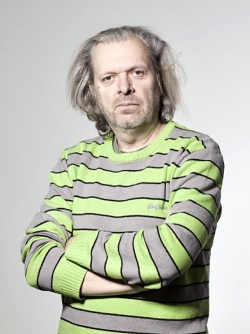
The pavilion at the Venice Biennale will be prepared by Jiří David
 |
The author himself does not want to talk too much about the exact form of the project; he only said today that the final shape will crystallize during the work. "For me, a certain liveliness of the project’s emergence is important," he said. He added that he sees winning the competition as a "challenge and an opportunity after many years to present something meaningful and significant beyond the context of Czech territory." In addition to art historian Rusnáková, who was briefly the director of the Collection of Modern and Contemporary Art at the NG, sociologist Jiří Přibáň also worked on the project preparation with David.
"The project by Jiří David and Katarína Rusnáková is very complex; it reflects the world we live in. As the only one, it is site-specific, intended only for that pavilion, reflecting its space and working with it," Budak stated. "The work contextualizes and seeks new meanings of works from Czech history, building a bridge between the individual and the collective, and the local and the international. It is both poetic and political," he added.
David leaves the pavilion almost empty, with the mentioned artwork on the rear wall, which is completely covered by a panel from the perspective of a viewer standing at the entrance. This panel is entirely white from the viewer's perspective, while on the other side, David's artwork will confront Mucha's painting. Apoteóza is the last work from the Slav Epic, created in 1926, and was meant to capstone the entire saga depicting the vision of Slavic triumph as an example for all humanity. Among the Slavic heroes are soldiers from the First World War. The main figure of the painting is a man with open arms, embodying the sufferings that Slavs had to endure for centuries, but also hope for a new republic.
Although the author does not want to interpret the work yet, commission members hint at various interpretations and contexts—related to the approaching centenary of the founding of Czechoslovakia, the anniversary of the start of the First World War this year, and the current war conflict in Ukraine. The contrast between Mucha’s work, which was already considered an anachronism by critics at the time of its creation, and the building that was created at the same time but belonged to contemporary progressive architecture is also interesting.
"It reflects the problem of memory—cultural, historical, collective. It raises questions related to the construction of concepts of people and homeland, works with a timeline of nearly one hundred years since the creation of the work, and will ask audiences what the phenomenon of Slavic identity meant in the past and how it is viewed today, as the local intermingles with the global," Rusnáková stated. She added that Jiří David's work has always had a political dimension, but it has never been visualized through simple, obvious metaphors.
The competition for the project for Venice was announced in April, when the evaluation committee was also published. Jiří Fajt took over as director of NG on July 1 and extended the deadline to September 8; based on his suggestion, foreign experts also joined the committee, and its composition was kept secret. It was chaired by Marta Giliová, director of the Jeu de Paume gallery in Paris, and included, alongside Budak, Rainer Fuchs, curator of the Vienna MUMOK, Alexandra Kusá, director of the Slovak National Gallery, Tomáš Vaněk, rector of AVU, artist Zbyněk Baladrán, winner of the previous competition, Petr Svojanovský from the Ministry of Culture, art historian Marie Klimešová, and Michal Koleček, dean of the Faculty of Art and Design at UJEP.
The commission was also impressed by the projects of Stanislav Kolíbal, Ladislava Gažiová, Magdalena Jetelová, and Krištof Kintera.
The English translation is powered by AI tool. Switch to Czech to view the original text source.
0 comments
add comment












